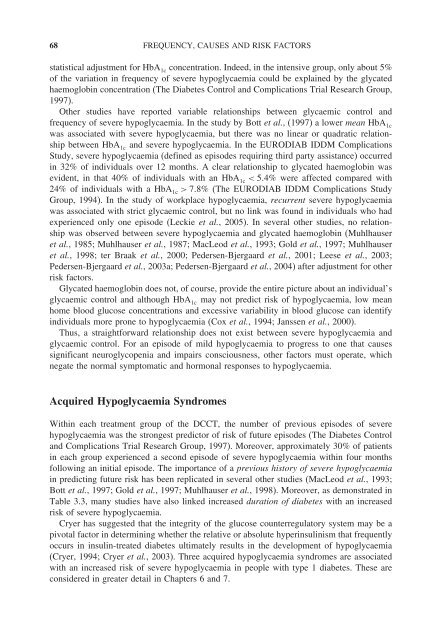Hypoglycaemia in Clinical Diabetes
Hypoglycaemia in Clinical Diabetes
Hypoglycaemia in Clinical Diabetes
- No tags were found...
Create successful ePaper yourself
Turn your PDF publications into a flip-book with our unique Google optimized e-Paper software.
68 FREQUENCY, CAUSES AND RISK FACTORSstatistical adjustment for HbA 1c concentration. Indeed, <strong>in</strong> the <strong>in</strong>tensive group, only about 5%of the variation <strong>in</strong> frequency of severe hypoglycaemia could be expla<strong>in</strong>ed by the glycatedhaemoglob<strong>in</strong> concentration (The <strong>Diabetes</strong> Control and Complications Trial Research Group,1997).Other studies have reported variable relationships between glycaemic control andfrequency of severe hypoglycaemia. In the study by Bott et al., (1997) a lower mean HbA 1cwas associated with severe hypoglycaemia, but there was no l<strong>in</strong>ear or quadratic relationshipbetween HbA 1c and severe hypoglycaemia. In the EURODIAB IDDM ComplicationsStudy, severe hypoglycaemia (def<strong>in</strong>ed as episodes requir<strong>in</strong>g third party assistance) occurred<strong>in</strong> 32% of <strong>in</strong>dividuals over 12 months. A clear relationship to glycated haemoglob<strong>in</strong> wasevident, <strong>in</strong> that 40% of <strong>in</strong>dividuals with an HbA 1c < 54% were affected compared with24% of <strong>in</strong>dividuals with a HbA 1c > 78% (The EURODIAB IDDM Complications StudyGroup, 1994). In the study of workplace hypoglycaemia, recurrent severe hypoglycaemiawas associated with strict glycaemic control, but no l<strong>in</strong>k was found <strong>in</strong> <strong>in</strong>dividuals who hadexperienced only one episode (Leckie et al., 2005). In several other studies, no relationshipwas observed between severe hypoglycaemia and glycated haemoglob<strong>in</strong> (Muhlhauseret al., 1985; Muhlhauser et al., 1987; MacLeod et al., 1993; Gold et al., 1997; Muhlhauseret al., 1998; ter Braak et al., 2000; Pedersen-Bjergaard et al., 2001; Leese et al., 2003;Pedersen-Bjergaard et al., 2003a; Pedersen-Bjergaard et al., 2004) after adjustment for otherrisk factors.Glycated haemoglob<strong>in</strong> does not, of course, provide the entire picture about an <strong>in</strong>dividual’sglycaemic control and although HbA 1c may not predict risk of hypoglycaemia, low meanhome blood glucose concentrations and excessive variability <strong>in</strong> blood glucose can identify<strong>in</strong>dividuals more prone to hypoglycaemia (Cox et al., 1994; Janssen et al., 2000).Thus, a straightforward relationship does not exist between severe hypoglycaemia andglycaemic control. For an episode of mild hypoglycaemia to progress to one that causessignificant neuroglycopenia and impairs consciousness, other factors must operate, whichnegate the normal symptomatic and hormonal responses to hypoglycaemia.Acquired <strong>Hypoglycaemia</strong> SyndromesWith<strong>in</strong> each treatment group of the DCCT, the number of previous episodes of severehypoglycaemia was the strongest predictor of risk of future episodes (The <strong>Diabetes</strong> Controland Complications Trial Research Group, 1997). Moreover, approximately 30% of patients<strong>in</strong> each group experienced a second episode of severe hypoglycaemia with<strong>in</strong> four monthsfollow<strong>in</strong>g an <strong>in</strong>itial episode. The importance of a previous history of severe hypoglycaemia<strong>in</strong> predict<strong>in</strong>g future risk has been replicated <strong>in</strong> several other studies (MacLeod et al., 1993;Bott et al., 1997; Gold et al., 1997; Muhlhauser et al., 1998). Moreover, as demonstrated <strong>in</strong>Table 3.3, many studies have also l<strong>in</strong>ked <strong>in</strong>creased duration of diabetes with an <strong>in</strong>creasedrisk of severe hypoglycaemia.Cryer has suggested that the <strong>in</strong>tegrity of the glucose counterregulatory system may be apivotal factor <strong>in</strong> determ<strong>in</strong><strong>in</strong>g whether the relative or absolute hyper<strong>in</strong>sul<strong>in</strong>ism that frequentlyoccurs <strong>in</strong> <strong>in</strong>sul<strong>in</strong>-treated diabetes ultimately results <strong>in</strong> the development of hypoglycaemia(Cryer, 1994; Cryer et al., 2003). Three acquired hypoglycaemia syndromes are associatedwith an <strong>in</strong>creased risk of severe hypoglycaemia <strong>in</strong> people with type 1 diabetes. These areconsidered <strong>in</strong> greater detail <strong>in</strong> Chapters 6 and 7.
















